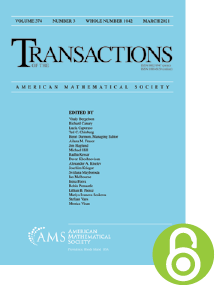Mixed Hodge structures
HTML articles powered by AMS MathViewer
- by Fouad El Zein PDF
- Trans. Amer. Math. Soc. 275 (1983), 71-106 Request permission
Abstract:
The theory of Mixed Hodge Structures (M.H.S.) on the cohomology of an algebraic variety $X$ over complex numbers was found by Deligne in 1970. The case when $X$ is a Normal Crossing Divisor is fundamental. When the variety $X$ is embedded in a smooth ambient space we get the Mixed Hodge Structure using standard exact sequences in topology. This technique uses resolution of singularities one time for a complete variety and $2$ times for a quasi-projective one. As applications to the study of local cohomology we give the spectral sequence to the Mixed Hodge Structure on cohomology with support on a subspace $Y$.References
- Pierre Deligne, Théorie de Hodge. II, Inst. Hautes Études Sci. Publ. Math. 40 (1971), 5–57 (French). MR 498551, DOI 10.1007/BF02684692 F. Elzein, Complexe dualisant et applications, Bull. Soc. Math. France, Mémoire No. 58, 1978. P. Griffiths and W. Schmid, Recent developments in Hodge theory, Proc. Internat. Colloq. Discrete Subgroups Lie Groups (Bombay), 1973. P. Deligne (Editor), Séminaire de Géométrie Algébrique SGA $4\frac {1} {2}$, Lecture Notes in Math., vol. 569, Springer-Verlag, Berlin and New York, 1977 (Catégories dériveé, by J. L. Verdier, p. 262).
- Jean-Louis Verdier, Stratifications de Whitney et théorème de Bertini-Sard, Invent. Math. 36 (1976), 295–312 (French). MR 481096, DOI 10.1007/BF01390015 —, Séminaire Bourbaki 1965/66, Exposé no. 300.
- Philippe Du Bois, Complexe de de Rham filtré d’une variété singulière, Bull. Soc. Math. France 109 (1981), no. 1, 41–81 (French). MR 613848, DOI 10.24033/bsmf.1932
Additional Information
- © Copyright 1983 American Mathematical Society
- Journal: Trans. Amer. Math. Soc. 275 (1983), 71-106
- MSC: Primary 14C30; Secondary 14F40, 18E30, 32J25
- DOI: https://doi.org/10.1090/S0002-9947-1983-0678337-5
- MathSciNet review: 678337


